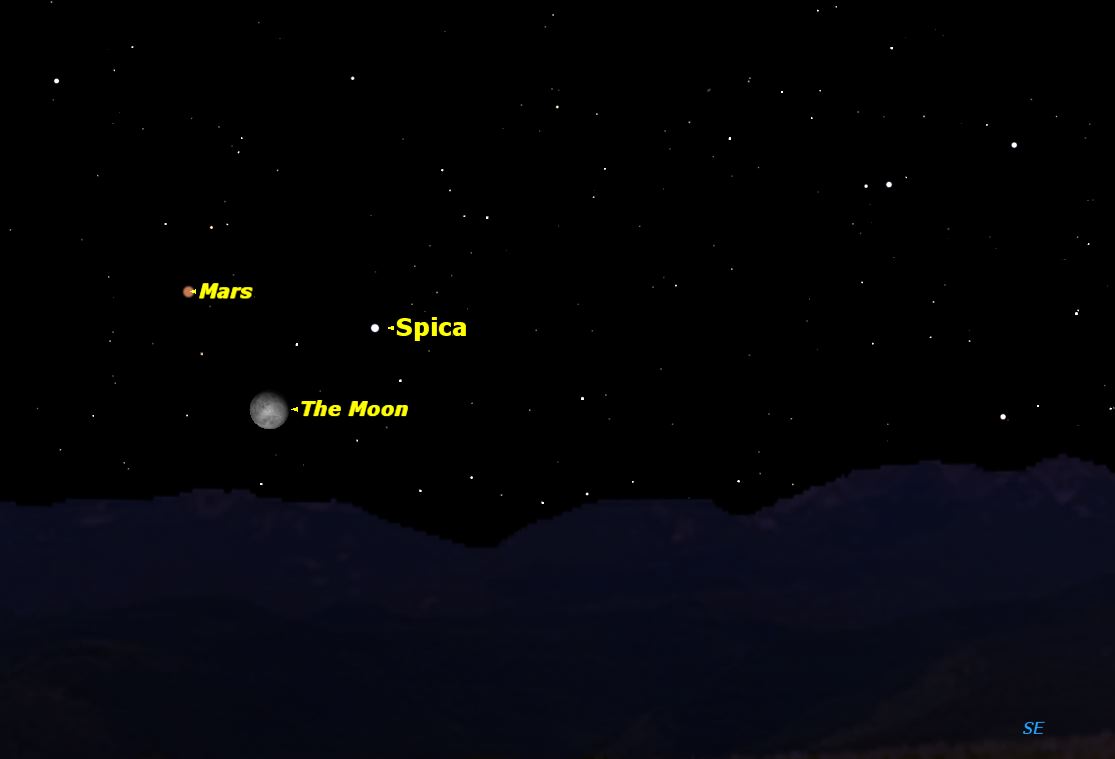
If the weather is clear where you live tonight (March 18), you just might get to enjoy a cosmic triple play: the moon, Mars and a bright star shining bright in what promises to be ab eye-catching site.
To see the celestial meet-up, look low above the east-southeast horizon at around 9:30 p.m. tonight (your local time). Weather permitting, you should see the waning gibbous moon accompanied by a very bright planet Mars on the upper left, with the bright blue star Spica to the upper right. The night sky trio, resembling an isosceles triangle, will be visible all through the rest of the overnight hours.
On this night, Mars will be 64 million miles (103 million kilometers) from Earth. The Red Planet will rise like a brand of fire in the east-southeast about two hours after sunset. It is currently rising about five minutes earlier each night. This golden-orange world has now flamed up to magnitude -1 on the brightness scale used by astronomers (objects with negative number magnitudes are exceptionally bright). [Amazing Night Sky Photos for March 2014]
Excluding the moon, Mars has now risen to the rank of the third brightest object in the pre-midnight evening sky, rivaled only by Jupiter and Sirius, the brightest star in the night sky. It will continue to brighten dramatically through the balance of this month. In contrast, Spica shines only one-sixth as bright. Good telescopic views become possible at about midnight, as soon as the planet has climbed well up out of the murky, shaky skies near the horizon.
Mars is currently proving to be a most thrilling — though also a most challenging — planetary target at this time. Through a 6-inch telescope, magnifying at 150-power, the disk of Mars — which measures 13 arc seconds across — will appear in the eyepiece to be as large as the moon would look to the unaided eye.
Mars will continue to slowly approach the Earth as it moves in its orbit over the next four weeks, the planet’s apparent size will continue to slowly grow through the planet’s closest encounter to us in mid-April. The planet is getting closer to Earth by about 244,000 miles (393,000 km) each day.
The north pole of Mars is well-tilted toward us this spring, and the Martian northern hemisphere summer is drawing toward its end. Look for the shrinking north polar ice cap as well as for increasingly prominent (though still elusive) dark surface features.
Get the Space.com Newsletter
Breaking space news, the latest updates on rocket launches, skywatching events and more!
Another hint of the coming close approach is the planet's change in course against the background stars.
After many months of direct (eastward) travel, Mars slowed to a crawl against the stars of Virgo in late February before beginning retrograde (westward) motion on March 1. It will pass 5 degrees north of Spica at the end of this month (your closed fist held out at arm's length covers 10 degrees of the night sky). Mars will not resume its normal eastward motion until May 21.
Editor's note:If you snap a great photo of Mars, the moon or any other night sky view and you'd like to share it for a possible story or image gallery, please contact managing editor Tariq Malik at spacephotos@space.com.
Joe Rao serves as an instructor and guest lecturer at New York's Hayden Planetarium. He writes about astronomy for Natural History magazine, the Farmer's Almanac and other publications, and he is also an on-camera meteorologist for News 12 Westchester, N.Y. Follow us @Spacedotcom, Facebook and Google+. Original article on Space.com.
Join our Space Forums to keep talking space on the latest missions, night sky and more! And if you have a news tip, correction or comment, let us know at: community@space.com.

Joe Rao is Space.com's skywatching columnist, as well as a veteran meteorologist and eclipse chaser who also serves as an instructor and guest lecturer at New York's Hayden Planetarium. He writes about astronomy for Natural History magazine, Sky & Telescope and other publications. Joe is an 8-time Emmy-nominated meteorologist who served the Putnam Valley region of New York for over 21 years. You can find him on Twitter and YouTube tracking lunar and solar eclipses, meteor showers and more. To find out Joe's latest project, visit him on Twitter.
